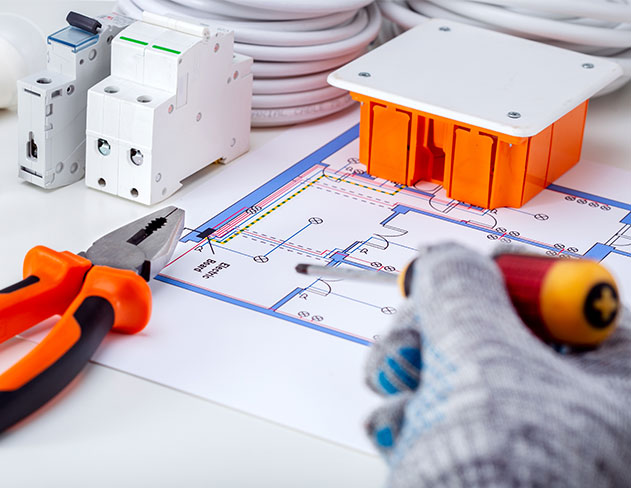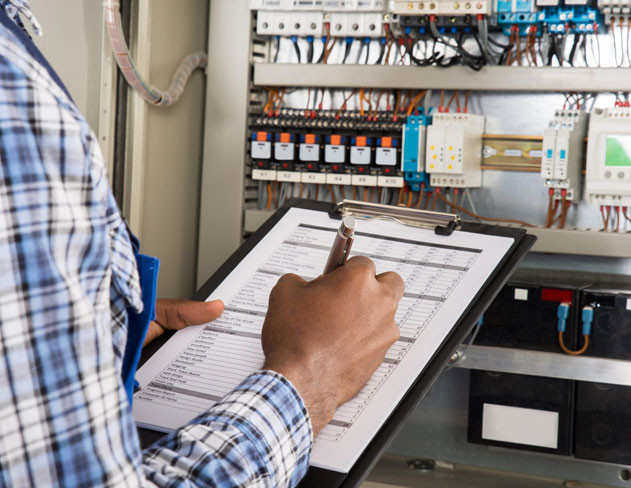What is Fixed Wire Testing?
Fixed wire testing is a critical procedure that ensures the safety and compliance of electrical installations that Hexo Electrical can carry out in properties across London and the South East. Homeowners and business owners need to understand why it’s so important as a cornerstone of electrical safety, particularly in rental properties. This guide’ll help you understand the significance, process, and benefits of fixed wire testing, emphasising its role in meeting legal requirements and safeguarding properties.
Behind the walls of every property lies a complex network of electrical installations. Fixed wire testing is the systematic process of inspecting and assessing these installations to ensure their safety and functionality. You can refer to this complete guide for a comprehensive understanding of commercial EICR.
Why Is Fixed Wire Testing Important?
Fixed wire testing is important because it is a protective barrier against potential electrical hazards. It allows you to identify faults that could lead to fires or electrocution. For commercial properties, this procedure is not just about ensuring safety—it’s about legal compliance. Adhering to health and safety regulations is necessary, and fixed wire testing ensures that property is safe.
What Are the Benefits of Fixed Wire Testing?
Fixed wire testing offers a range of benefits that reach beyond ensuring safety. It grants property owners peace of mind, knowing their electrical installations are in optimal condition. Moreover, it helps you to rest assured that you’re meeting legal obligations, ensuring properties remain compliant with regulations. When you proactively identify potential hazards, you can mitigate risks, preventing potential damages and injuries. In essence, fixed wire testing is an investment in the safety and longevity of a property.
What Does Wire Testing Involve?
Fixed wired testing allows you to probe for any faults that might compromise the electrical system’s safety. This could range from frayed wiring, which poses a fire hazard, to loose connections that could lead to equipment malfunction. Independent inspections also play a pivotal role, ensuring that any identified issues are promptly addressed, and necessary repairs or electrical servicing are advised. Remember, the fixed wire testing process is not just about identifying problems but rectifying them.
How Long Does a Fixed Wire Test Take?
Time is of the essence, especially for bustling businesses. The duration of a fixed wire test largely depends on the size and complexity of the electrical installation in question. For instance, a small retail outlet might require less time compared to a large commercial building with multiple floors and circuits. However, with Hexo Electrical’s team of qualified and efficient engineers, you can expect minimal disruption to your operations. They’re trained to conduct tests swiftly without compromising on thoroughness, helping your business to resume its regular rhythm as soon as possible.
Who Is Responsible for An EICR Test?
While contractors are equipped to perform the EICR test, the responsibility ultimately falls on the property owner. Whether you own a residential premise in London or a commercial space in the South East, it’s your legal obligation to ensure the health and safety of all occupants. This means not only commissioning the test but also acting on its findings. Hexo Electrical emphasises the importance of understanding and fulfilling these responsibilities, ensuring that every property remains compliant and safe.
Regulations & Standards
Navigating the realm of fixed wire testing requires a keen understanding of its regulations and standards. These aren’t just bureaucratic checkboxes; they’re the foundation of electrical safety, ensuring that every property, whether residential or commercial, adheres to the highest safety and compliance standards.
Legal Requirements for Fixed Wire Testing
The legal landscape of fixed wire testing is anchored by two pivotal regulations: the Health and Safety at Work Act 1974 and the Electricity at Work Regulations 1989. These regulations mandate the safety of electrical installations, ensuring that they pose no risk to occupants or users. Fixed wire testing serves as tangible evidence of compliance with these regulations. Moreover, it’s worth noting that many commercial insurers often require evidence of regular fixed wire testing, further underscoring its importance.
How Often Do You Need a Fix Wire Text?
The frequency of fixed wire testing is not a one-size-fits-all answer. It varies based on the type of premises and the inherent risks associated. For instance, industrial premises should undergo testing every three years given their complex electrical needs. In contrast, retail outlets and commercial offices can extend this interval to every five years. However, certain environments, like swimming pools or businesses with significant exposure to liquids, necessitate more frequent testing. If you’re ever in doubt, Hexo Electrical is just a call away, ready to offer expert guidance on the ideal frequency for your property.
Identifying Risk & Potential Hazards
The essence of fixed wire testing lies in its ability to identify and mitigate risks. It’s a proactive approach, ensuring that potential hazards are addressed before they escalate into tangible threats. Understanding these risks is the first step towards ensuring unwavering safety, whether it’s a commercial space bustling with activity or a serene residential property.
Identifying Dangers In Electrical Installations
Electrical installations, while essential, come with their set of potential dangers. Fixed wire testing is instrumental in highlighting these risks. For instance, it’s imperative to isolate all phase conductors before working on any electrical circuit, except when specific tests or procedures dictate otherwise. This ensures the safety of the test personnel and prevents any inadvertent electrical mishaps.
Assessing The Risk Of Injury/Damage To Property
The very essence of fixed wire testing revolves around risk assessment. It’s not just about identifying potential hazards but understanding their implications. A visual inspection during the testing process can reveal issues in the electrical installation, such as faulty wiring or inadequate earthing. Recognising these risks is crucial, but addressing them is even more vital. By rectifying these issues, property owners ensure their premises’ safety and proper functioning, safeguarding both people and property.
Types of Tests and Inspections Carried Out During Fixed Wire Testing
Fixed wire testing is a multifaceted procedure encompassing a range of tests and inspections. Each test serves a specific purpose, ensuring that every aspect of the electrical installation is scrutinised for safety and functionality.
Visual Inspections
At the heart of fixed wire testing are visual inspections. These inspections assess the visible components of the electrical installation, such as wiring, socket outlets, light fittings, and consumer units. It’s a thorough examination, ensuring that even permanently connected equipment like showers and extractors are up to standard. While it might seem basic, visual inspections are often the first line of defence, identifying potential issues before they escalate.
Insulation Resistance Test (IR Test)
Diving deeper into the technicalities of fixed wire testing, the Insulation Resistance Test, commonly known as the IR Test, stands out. This test is pivotal in gauging the quality of insulation around conductors, ensuring it effectively prevents unintended current flow. By applying a high voltage, typically between conductors and earth, the test identifies potential electrical hazards, ensuring the safety of the installation. The process involves specific equipment, including insulation resistance testers, to measure resistance values and ascertain the integrity of the insulation.
Earth Continuity Test
Safety in electrical installations often hinges on the principle of earthing. The Earth Continuity Test ensures that the electrical conductive path, especially the metallic parts of an installation, is properly connected to the earth, providing a low impedance path. This is crucial in preventing electric shock in case of a fault. The test involves measuring the resistance between the earth terminal and various points in the installation, ensuring continuity and safety.
Polarity Test
Ensuring the correct connection of live, neutral, and earth wires is paramount for the safe operation of electrical equipment. Enter the Polarity Test. Conducted during fixed wire testing, this test verifies that all connections are correctly made, ensuring electrical safety and compliance. Specialised tools and equipment are employed to check the polarity of socket outlets, switches, and other components, ensuring they are wired correctly.
Equipment Used For Fixed Wire Testing
The precision and accuracy of fixed wire testing hinge on the equipment used. A thorough assessment is conducted, from main panels and distribution boards to lights, plug sockets, and air conditioning units. The testing process encompasses both visual inspections and electronic tests on all these systems, barring equipment that’s plugged in. Essential tools for the procedure include multimeters, insulation resistance testers, and polarity testers, ensuring a comprehensive assessment of the property’s electrical health.
Understanding Your EICR Report
Receiving an EICR (Electrical Installation Condition Report) post-testing is akin to getting a health report after a medical check-up. It provides a detailed overview of the condition of your electrical installations, highlighting any areas of concern.
What do the EICR Observation Codes Mean?
Deciphering the EICR observation codes is crucial for understanding the safety level of your electrical installations. These codes, namely C1, C2, C3, and FI, are used to categorise the risk posed by identified electrical issues. For instance, while C1 indicates a danger that requires immediate attention, C3 might suggest improvements that aren’t necessarily urgent but are recommended.
What Should You Do if the EICR Report Is Unsatisfactory?
An unsatisfactory EICR report is a call to action. It indicates that there are electrical defects that need immediate attention. By law, these defects must be rectified to ensure the safety of the property and its occupants. Once the necessary repairs are made, you should maintain documentation to demonstrate that you’ve addressed the defects. Remember, even if Hexo Electrical didn’t conduct the initial testing, we offer professional remedial and repair work to ensure your property meets the required standards.
FAQs
Here are some of the frequently asked questions about Electrical Safety Testing.
Is Fixed Wire Testing A Legal Requirement?
Fixed wire testing is a legal requirement, especially for commercial properties. Governed by regulations such as the Health & Safety at Work Act 1974 and the Electricity at Work Regulations 1989, fixed wire testing ensures that electrical installations are safe and compliant. The frequency of testing depends on various factors, including the type of premises and associated risks.
Is Fixed Wire Testing the Same as PAT Testing?
Fixed wire testing and PAT (Portable Appliance Testing) are distinct procedures. While fixed wire testing focuses on the inspection of fixed electrical installations, PAT testing is concerned with the examination of portable electrical equipment and appliances.
How Much Does a Fixed Wire Test Cost?
The cost of a fixed wire test varies based on the specific electrical installation being assessed and the type of building. You can refer to this article for more detailed information on the factors that affect the cost of an EICR.
For businesses, the prices at Hexo Electrical start at £169 for up to 10 circuits, with an additional £10 for each extra circuit. On the other hand, domestic properties have prices starting at £80 for a studio, with variations based on the number of bedrooms and the time of day. It’s important to note that while factors such as the age of the installation, the inspector’s experience, and potential remedials might influence the cost to Hexo Electrical, the price to the client remains fixed based on the aforementioned criteria

